You’re exhausted, your newborn won’t sleep unless they’re close to you, and you’re wondering if co-sleeping is the answer. But is it safe? Let’s break down everything you need to know.

Co-sleeping is a topic that sparks strong opinions among parents and experts alike. While some families swear by its benefits, others worry about safety risks. If you’re considering co-sleeping, it’s important to understand the different methods, potential benefits, and how to ensure your baby sleeps safely.
Here is everything you need to know about co-sleeping with your baby, including specific tips for newborns, small bedrooms, twins, and breastfeeding mothers.
What is Co-Sleeping?
Co-sleeping refers to sleeping close to your baby. Many parents choose co-sleeping to promote bonding, make nighttime feedings easier, or simply because their baby sleeps better when close.
There are different ways to co-sleep with your baby, from bed-sharing to keeping a crib within arm’s reach. Each has its benefits, but some also raise considerations you should know. If you choose to co-sleep, it’s essential to follow safe sleep guidelines to minimize risks.
? Curious about the benefits of co-sleeping? Learn how it can help both you and your baby in our in-depth guide: Benefits of Co-Sleeping With Baby.
Ways to co-sleep with your baby
- Bed-Sharing: Parents and baby sleep on the same surface, such as a bed. While it fosters bonding and makes nighttime feedings easier, it carries the highest risk of suffocation and SIDS.
- Snuggle Nest (In-Bed Co-Sleeper): A small, portable sleep space with raised sides that is placed directly on the parents’ bed. It offers a barrier between the baby and parents, but still carries risks.
- Sidecar Arrangement: A bassinet or co-sleeper attaches securely to the parents’ bed, allowing easy access to the baby while maintaining a separate sleep surface. Proper setup is crucial to ensure there are no gaps between the bed and the co-sleeper. If done correctly, it is a safe option.
- Room-Sharing with a Bedside Crib or Bassinet: Baby sleeps in a crib or bassinet next to the parents’ bed, making nighttime care convenient while keeping them in a separate, safe sleep space. Pediatric experts consider this the safest co-sleeping option.
- Room-Sharing with a Separate Sleep Space: Baby sleeps in a crib or bassinet in the same room but not directly next to the parents’ bed. This still allows parents to monitor their baby while providing slightly more space, and is a safe way of co-sleeping with your baby.
? Want a more detailed breakdown of each method? Check out our full guide on Different Types of Co-Sleeping for in-depth explanations and what to consider for each setup.
The controversy about co-sleeping will probably never end. For those who practice it, it’s normal and healthy. For those who don’t, it’s dangerous and irresponsible. Of course, this relates primarily to bed-sharing, not co-sleeping in general. Regardless of what option you pick, follow the safety precautions!
? Thinking about whether co-sleeping is the right choice for your family? Don’t miss our full breakdown of the Pros and Cons of Co-Sleeping with Your Baby, including insights on how it affects sleep, bonding, and safety.
How to Co-Sleep with a Baby Safely?
When co-sleeping, the goal is for all family members to get a good night’s sleep, but above all, your baby’s safety comes first! Experts recommend that infants sleep in their parents’ room for at least the first six months, ideally for the entire first year.
The American Academy of Pediatrics (AAP) strongly advises against bed-sharing and instead recommends room-sharing as the safest co-sleeping practice. Studies show that room-sharing without bed-sharing can reduce the risk of SIDS (Sudden Infant Death Syndrome) by up to 50%.
The Safest Co-Sleeping Options
(Ranked from Least to Most Safe)
The safest way to co-sleep is by keeping your baby close while providing a separate, secure sleep space. The American Academy of Pediatrics (AAP) strongly advises against bed-sharing but supports room-sharing as the safest co-sleeping method. Studies show this practice can reduce the risk of SIDS by up to 50%.
1. Bed-Sharing (Least Safe)
While bed-sharing fosters bonding and makes nighttime feedings easier, it significantly increases the risk of suffocation, overheating, and Sudden Infant Death Syndrome (SIDS). Soft bedding, gaps, and parental movement pose serious risks, making this the least safe option.
2. In-Bed Co-Sleepers (Slightly Safer)
Products like snuggle nests provide a designated sleep area within the parents’ bed. While they create a barrier, they do not eliminate all risks. Thus, the AAP does not recommend this co-sleeping arrangement.
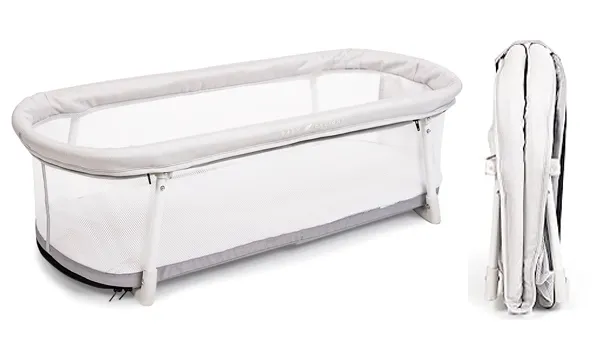
If you decide to go with this option anyway, the Baby Delight Snuggle Nest has sturdy, breathable sides and a compact design.
3. Bedside Sleeper or Bedside Bassinet (Safer)
A side-sleeper or bassinet attaches securely to the parents’ bed, keeping the baby within reach while maintaining a separate sleeping surface. Choose a sturdy model that attaches well and meets all necessary safety standards. This setup allows for easy nighttime care while reducing the risks associated with bed-sharing.
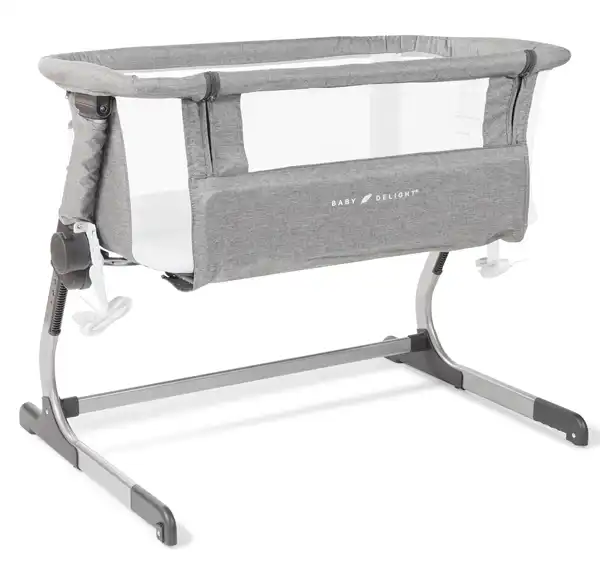
The Baby Delight Beside Me Dreamer Bassinet is a great option, offering a firm, stable design that attaches securely to the parents’ bed.
4. A Stand-Alone Crib or Bassinet in the Room (Even Safer)
Placing a crib or stand-alone bassinet in the parents’ room—but not directly beside the bed—provides a safe, separate sleep space while still allowing for easy monitoring.
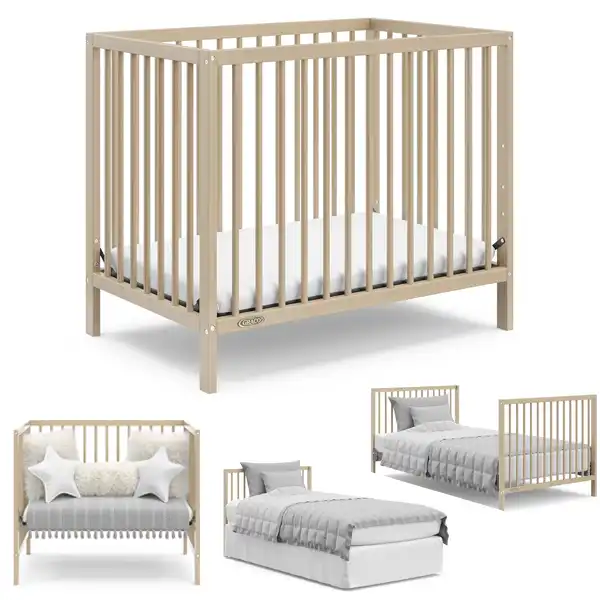
If you’re looking for a safe and versatile option, the Graco Teddi 4-in-1 Convertible Mini Crib is an excellent choice. Its convenient size, included mattress, and GREENGUARD Gold certification make it a great fit for smaller spaces while still providing a secure sleep environment.
? Prefer a full-size crib? Check out our guide: Best Cribs of the year
5. A Stand-Alone Crib or Bassinet Next to the Parents’ Bed (Safest)
The AAP cites a crib or bassinet placed next to the parents’ bed as the safest sleeping arrangement. This arrangement allows for easy monitoring while providing a separate, secure sleep space.
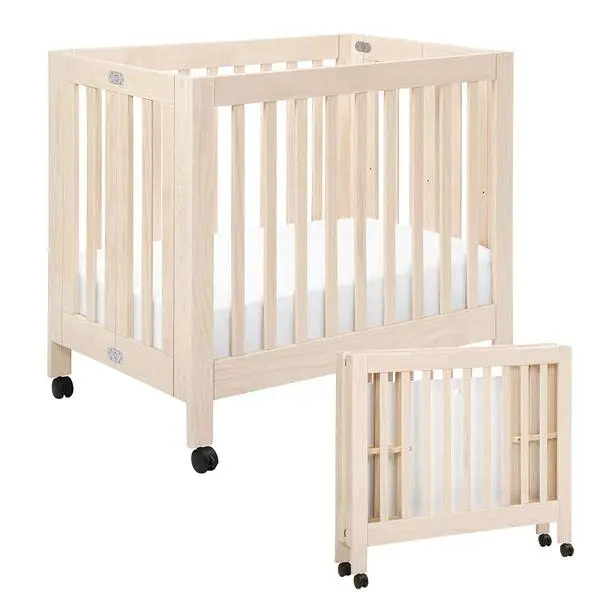
The Babyletto Origami Mini Crib is one of the best choices for this setup. Its compact yet sturdy design allows for easy placement next to the bed while ensuring a safe and separate sleep environment.
Something to think about:
- Bassinets are great for newborns, but most are only suitable for the first 4–6 months. Once babies start moving more, they may outgrow them quickly.
- A full-size crib is the most practical long-term option, though it requires more space in the bedroom.
- Mini cribs offer a space-saving alternative that lasts longer than a bassinet while maintaining a compact footprint.
Additional Guidelines for Your Newborn’s Safe Sleep:
- Always place your baby on their back for every sleep.
- Use a firm, flat sleep surface without pillows, blankets, or bumpers.
- Keep the sleep space clear—no stuffed animals, loose bedding, or extra items.
- Maintain a cool room temperature (68-72°F) to prevent overheating.
- Avoid swaddling if bed-sharing, as it can lead to overheating and restrict movement. Instead, dress your baby lightly.
- Breastfeeding may reduce the risk of SIDS, according to studies.
Co-sleeping is never a great solution if all involved family members do not feel comfortable with it. If someone does not want it, you should not force them into it.
What if I want to bed share with my baby anyway?
Some parents choose to bed-share despite the risks. If you decide to do so, follow these safety precautions:
How to Make Bed-Sharing as Safe as Possible
- Use a firm mattress without any loose sheets.
- Never sleep with your baby on a sofa, armchair, waterbed, pillow-top mattress, couch, or any other soft surface.
- The mattress should fit snugly against the bed frame with no gaps.
- Keep blankets and pillows away from the baby. Instead, dress your baby in a sleep sack. Use only light bedding for yourself, avoiding cushions, long strips, or cords. There should be no toys or animals in the bed either.
- Place the baby on your side, not between two adults. This reduces the risk of accidental suffocation.
- Make sure the baby can’t fall off the bed. Consider placing the mattress directly on the floor or using bed rails designed for infants.
- Never bed-share if you smoke, have consumed alcohol, or are overly tired.
- If you have long hair, tie it back to prevent it from wrapping around your baby’s neck.
Do NOT Bed-Share if:
- You are a smoker.
- Your baby is premature or has a low birth weight.
- You have consumed alcohol, sedatives, or drugs.
- You are overly tired or a deep sleeper.
- You or your partner are extremely obese.
- There are older siblings in the bed.
Co-Sleeping Solutions for Small Bedrooms
Limited space doesn’t have to mean giving up on co-sleeping. Here are some space-saving ideas:
1. Bedside Bassinets with a Slim Profile
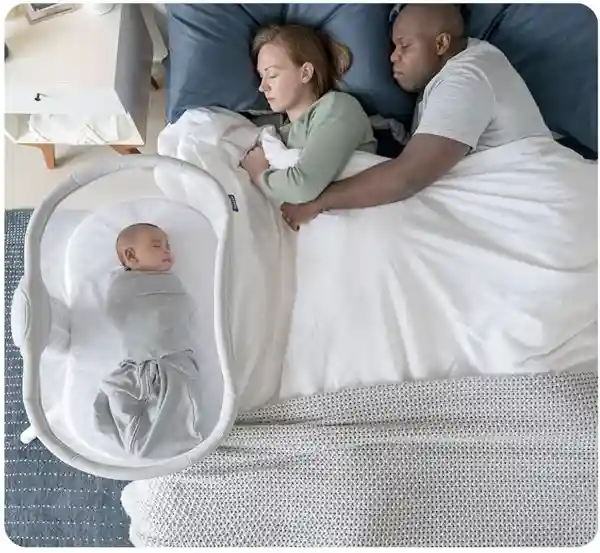
A bedside bassinet with a slim profile keeps your baby close while maximizing space. Look for models with a slim profile and a compact base that slides partially under your bed to save floor space.
The HALO BassiNest Swivel Sleeper is a great choice for small spaces. Its 360-degree swivel allows you to bring your baby closer without taking up extra floor space, and its vibrations, soothing sounds, and built-in nightlight help create a calming sleep environment. The slim base tucks partially under your bed, which can save space in the room.
2. Foldable Cribs
Foldable cribs can be a great option for those who want a longer-lasting solution that saves space. These cribs:
- Can be full-size or mini, depending on your needs and space.
- Have sleek frames to occupy as little space as possible.
- Collapse flat for easy storage when not in use.
- Usually stand on wheels.
- Work well for small apartments or multi-purpose rooms.

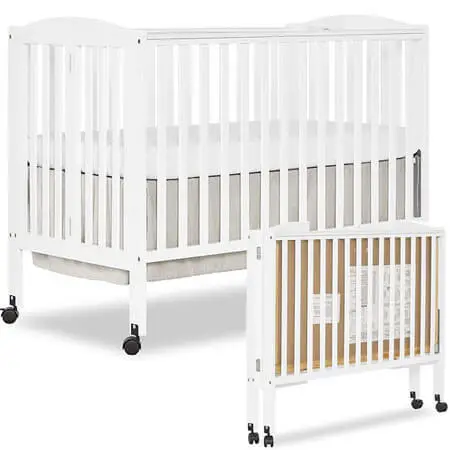
Popular choices include the Babyletto Origami Mini Crib, which is a stylish foldable mini crib on wheels, and the Dream On Me Full-Size Folding Crib, which is a standard-size crib with a slim profile that also stands on wheels and folds without requiring disassembly.
3. Mini Convertible Cribs or Pack ‘N Plays
Mini convertible cribs and Pack ‘N Plays offer compact yet functional sleeping spaces:
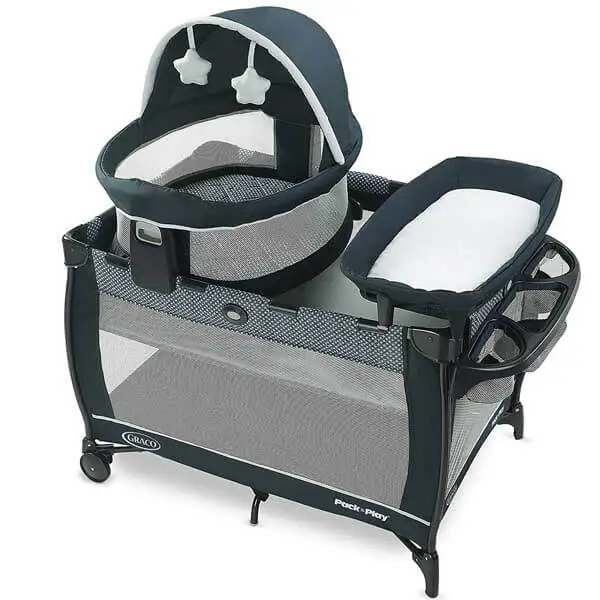
Pack ‘N Plays: These are highly portable, easy to fold, and often come with a bassinet attachment for newborns. The Graco Pack ‘N Play Travel Dome LX is a great space-saving choice with a removable bassinet.
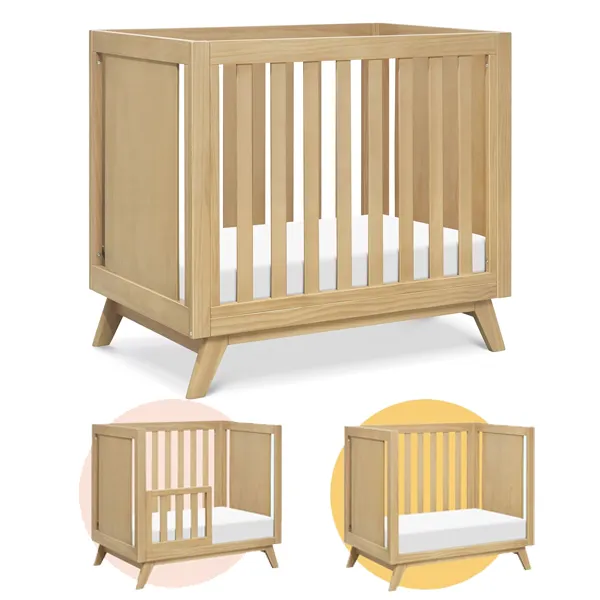
Mini Cribs: These are smaller than full-size cribs but sturdier than bassinets, making them a good long-term option. The DaVinci Otto 3-in-1 Convertible Mini Crib is a sturdy option that grows with your baby, converting from a mini crib to a mini toddler bed and daybed.
Co-Sleeping with Twins
Parents of twins often wonder if co-sleeping is an option. While it comes with unique challenges, there are safe ways to keep them close at night.
The safest option is room-sharing with separate sleep spaces, such as twin bassinets or cribs. Some parents use special twin bassinets or playards designed for two, offering convenience while maintaining safe sleep practices. Co-bedding in the same crib is also an option for the first few months, but it should be done with caution.
For a detailed guide on co-sleeping with twins, including recommended products and safety tips, check out Co-Sleeping with Twins: Tips and Advice.
How long should I co-sleep with my baby?
Co-sleeping should continue as long as it works for your family. If everyone sleeps well and feels comfortable, there is no rush to stop. However, if co-sleeping begins to affect anyone negatively, it may be time to transition to independent sleep.
The duration of co-sleeping also depends on the method you choose. Babies will outgrow certain sleep spaces faster than others—for example, bassinets and bedside sleepers are typically designed for the first few months, while cribs and playards can be used much longer. Keeping your baby’s growth and sleep needs in mind will help you determine the right time to transition.
Final Thoughts
Co-sleeping can be a wonderful way to bond with your baby and make nighttime parenting easier, but safety should always come first. Whether you choose room-sharing, a bedside bassinet, or another arrangement, following best practices will help ensure a secure and restful sleep for both you and your baby.
